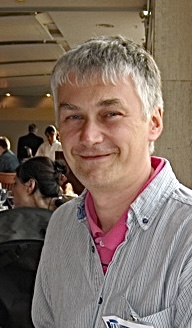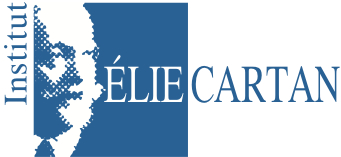 French version
French version
JOURNÉES SL2R
(Strasbourg, Lorraine, Louvain-la-Neuve, Luxembourg, Reims)
REPRESENTATION THEORY AND HARMONIC
ANALYSIS
in celebration of the 60th birthday of
Pavle Pandžić
|

|
Organizing
Committee:
Philippe Bonneau, Salah Mehdi, Angela
Pasquale
Program
Speakers:
Alexandre AFGOUSTIDIS (University of Lorraine)
Léa BITTMANN (University of Strasbourg)
Hrvoje KRALJEVIĆ (University of Zagreb)
Andrey KRUTOV (Charles University)
Salah MEHDI (University of Lorraine)
Martin OLBRICH
(Universit of Luxembourg)
Ana PRLIĆ
(University of Zagreb)
Haluk
ŞENGÜN
(University of Sheffield)
Rupert YU
(University of Reims)
Conferences:
Petit Amphi, Bâtiment UFR-MIM
Coffee breaks:
Salle des conférences of the IECL
Program:
The workshop will begin on Thursday at the beginning of the afternoon with a
talk on Dirac operators aimed at a "general public" and more
specifically Ph.D. students, future Ph.D. students and master's students passionate about fundamental mathematics.
Thursday, November 9
Friday, November 10
| 8:45-9:45 |
Rupert YU:
On a combinatorial problem concerning seaweed Lie algebras
|
| 9:45-10:15 |
Coffee Break
|
| 10:15-11:15 |
Haluk ŞENGÜN:
Theta correspondence via $C^*$-algebras
|
| 11:15-12:15 |
Martin OLBRICH:
The continuous spectrum of certain compact locally symmetric spaces
|
| 12:20 |
Lunch |
| 14:00-15:00 |
Léa BITTMANN:
Skein modules and Double Affine Hecke Algebras
|
| 15:00-16:00 |
Alexandre AFGOUSTIDIS:
Recent developments on supercuspidal representations
|
Titles and abstracts
of the conferences:
General public talk
Salah MEHDI:
Dirac or the incredible mathematical odyssey of a free electron
Between 1900 and 1915, anni mirabiles, German physicists Albert Einstein and Max Planck revolutionized Physics and sent Newton back to the dressing room. The theory of quanta and the theory of relativity challenge intuition, opening the doors of a vast world until then invisible, a world populated by atoms around which revolve, at crazy speeds, swarms of particles. In these atomic hives, all eyes are on the queen, light (about
$9\times 10^{-31}$ kilograms) and twirling (with spin $1/2$), named electron. But the queen stirs covetousness. In 1925, the paparazzi of the atom held a scoop: the Austrian physicist Erwin Schröodinger models the quantum but non-relativistic back and forth of the electron. The next year the Swedish Oskar Klein and the German Walter Gordon managed to relativize the model, yet without including the spin. Thus, despite his agility and his double-life, Schrödinger's cat fails to spy on the queen who continues to turn heads. For the umpteenth time, theoretical physicists have the spleen and find themselves in a dead end: how to describe with scalar waves the relativistic quantum dynamics of a spinning particle? It will take all the audacity and genius of the young British physicist Paul Dirac to lift the veil on the queen. In 1928, at the age of $25$, Dirac led the way and made a leap forward to think outside the box: he proposed an equation with vector solutions that captures the quantum, relativistic and spinning aspects of the free electron. Checkmath, the queen of particles abdicates after more than 13 billion years on the subatomic throne. The magic formula of the young revolutionary is however based on a simple differential operator of degree 1 with matrix constant coefficients. The Dirac operator was born, his immense kingdom will extend to the confluences of the mathematics: algebra, analysis and geometry. In this talk, we will discuss some episodes of Dirac's incredible odyssey, including its contributions to group theory, topology and analysis on manifolds. In particular, we will explain how the notion of invariance is the Ariane thread of most physical and mathematical theories. But let's say it right away: just like the electron once, the Dirac operator intrigues and fascinates. He has not yet revealed all its secrets, the adventure continues ...
Hrvoje KRALJEVIĆ:
A glimpse into the work of Pavle Pandzic
On the occasion of the 60th birthday of Pavle Pandzic I will give short overview of his career. Furthermore, I will try to present his achievements in representation theory, especially by using Dirac operators.
Ana PRLIĆ:
Alternative proof of the classification of unitary highest weight modules
In this talk, we give an alternative proof of the classification of unitary highest weight modules given by Enright, Howe and Wallach
(and independently by Jakobsen). This is joint work with Pavle Pandžić, Vladimir Souček and Vit Tuček.
Andrey KRUTOV:
Cubic Dirac operator for $U_q(\mathfrak{sl}_2)$
Alekseev and Meinrenken developed a noncommutative equivariant de Rham theory for homogeneous manifolds equipped with a transitive action of a Lie group $G$. This led to the definition of a noncommutative Weil algebra related to the algebra $\mathfrak{g}$ of $G$. If the Lie algebra $\mathfrak{g}$ admits a nondegenerate invariant bilinear form, then the noncommutative Weil algebra comes equipped with a cubic Dirac element. Since this Dirac element squares to a scalar, it can be seen as an algebraic Dirac operator. Such Dirac operators have numerous applications in geometry and representation theory. In particular, they were used to give a new proof of the celebrated Duflo theorem.
We define the $q$-deformed noncommutative Weil algebra for the quantum group $U_q(\mathfrak{sl}_2)$ and the corresponding cubic Dirac element. We calculate the spectrum of the Dirac operator and the corresponding Dirac cohomologies for finite-dimensional and Verma modules over $U_q(\mathfrak{sl}_2)$.
This is joint work with Pavle Pandžić (Zagreb).
Rupert YU: On a combinatorial problem concerning seaweed Lie algebras
Seaweed Lie algebras were introduced
by Dergachev and Kirillov in 2000 and provided
many new examples of complex Frobenius Lie
algebras, that is, a Lie algebra whose coadjoint
action has an open orbit. The original definition
is only for gl(n), and the notion was generalized
by Panyushev to any reductive Lie algebras. As in
the case of parabolic subalgebras in a reductive
Lie algebra, any seaweed Lie algebra is conjugate
to some standard one. Duflo et Elashvili observed
independently some behaviour on the growth of the
number of standard Frobenius seaweed Lie algebras
in gl(n) with respect to n. In this talk, we shall
present some results concerning the validity of
these observations.
This is based on joint works with Michel Duflo.
Haluk ŞENGÜN: Theta correspondence via $C^*$-algebras
The local theta correpsondence sets up a bijection between
certain subsets of admissible duals of suitable pairs of reductive
groups. There are two special cases in which the correspondence is known
to enjoy extra features, the ‘equal rank’ case where temperedness is
preserved and the ‘stable range’ case where unitarity is preserved.
In joint work with Bram Mesland (Leiden), we show that in these special
cases, the local theta correspondence is actually given by a Morita
equivalence of suitable $C^*$-algebras. I will try to expose this result
and, time permitting, some applications.
Martin OLBRICH: The continuous spectrum of certain compact locally symmetric spaces
Let $X=G/H$ be a semi-simple non-Riemannian symmetric space. We consider compact `standard quotions' $Y$ of $X$: There exists a reductive connected subgroup $L\subset G$
acting transitively on $X$ with compact stabilizers and a cocompact discrete subgroup $\Gamma\subset L$ such that $Y=\Gamma\backslash X$. We are interested in the joint spectral
decomposition of $L^2(Y)$ with respect to the action of the algebra $D(G/H)$ of $G$-invariant differential operators on $X$. There is a sufficient criterion in terms
of the triple $(G,H,L)$, which ensures that the spectral decomposition is purely discrete. We conjecture that this criterion is also necessary. In particular, many compact standard quotients
should have continuous spectrum. We give reasons to believe in this conjecture and verify it in the simplest cases (which are connected with $SL(2,\mathbb{R}$).
This is joint work with Salah Mehdi.
Léa BITTMANN: Skein modules and Double Affine Hecke Algebras
The type A Hecke algebra of rank n is a deformation of the group algebra of the braid group on n strands $\mathcal{B}_n$. This is true in more generality, in particular, the affine Hecke algebra is a deformation of the group algebra of the affine braid group, which can be defined as braids in a (thickened) annulus. As such, the affine Hecke algebra is the braid skein algebra of the annulus. Morton and Samuelson have proved that the Double Affine Hecke Algebra (DAHA) is isomorphic to the braid skein algebra of the punctured torus. They also conjectured that these were isomorphic to the corresponding tangle skein algebra, where braids are replaced by tangles (or ribbons). In this talk, I will present a proof of the Morton-Samuelson conjecture, and a classification of a class of representation of the DAHA using doubly periodic tableaux. This is based on joint work with A. Chandler, A. Mellit and C. Novarini.
Alexandre AFGOUSTIDIS:
Recent developments on supercuspidal representations
[This will be a ''dress rehearsal'' for my talk at the Bourbaki seminar on November 18]
Let $G$ be a reductive group over a nonarchimedean local field $F$. In the quest for a classification of irreducible smooth representations of $G$, it is critical to understand the case of supercuspidal representations---those with compact-mod-center matrix coefficients. Progress in understanding these representations has been continuous over the past fifty years. In ``tame'’ cases where the residual characteristic of $F$ is big enough for $G$, a fairly general construction was described by J-K. Yu in 2001, building on a large body of work. But recent developments have made the general picture much more complete and much clearer. For instance, the work of J. Fintzen, T. Kaletha and L. Spice includes (in the tame case) a classification of supercuspidal representations, an explicit formula for ``almost all'' their characters, and an explicit construction of a local Langlands correspondence for supercuspidal L-packets. While the basic constructions crucially involve Bruhat--Tits buildings and representations of finite groups, the resulting character formulas and the description of $L$-packets have striking parallels with the case of real groups.
Participants
(last updated: 12/10/2023)
- Spyridon AFENTOULIDIS-ALMPANIS (Bar-Ilan University)
- Alexandre AFGOUSTIDIS (CNRS & Université de Lorraine)
- Wolfgang BERTRAM (Université de Lorraine)
- Léa BITTMANN (Université de Strasbourg)
- Philippe BONNEAU (Université de Lorraine)
- Jean-Louis CLERC (Université de Lorraine)
- David DECLERCQ-LUCET (Université de Reims)
- Karmen GRIZELJ (University of Zagreb)
- Auguste HÉBERT (Université de Lorraine)
- Perrine JOUTER (Université de Reims)
- Hrvoje KRALJEVIĆ (University of Zagreb)
- Andrey KRUTOV (Charles University)
- Gang LIU (Université de Lorraine)
- Valentin MARIE (Université de Reims)
- Hugo MATHEVET (Université de Reims)
- Salah MEHDI (Université de Lorraine)
- Victor NISTOR (Université de Lorraine)
- Martin OLBRICH (University of Luxembourg)
- Valentin OVSIENKO (Université de Reims)
- Guenda PALMIROTTA (Université du Luxembourg)
- Pavle PANDZIC (University of Zagreb)
- Angela PASQUALE (Université de Lorraine)
- Aurélie PAULL (Université de Lorraine)
- Emmanuel PEDON (Université de Reims)
- Ana PRLIĆ (University of Zagreb)
- Nicolas PRUDHON (Université de Lorraine)
- Haluk ŞENGÜN (University of Sheffield)
- Rafailia TSIAVOU (Aristotle University of Thessaloniki)
- Rupert YU (Université de Reims)
- Bob YUNCKEN (Université de Lorraine)
Registration
To register for these Journées, please fill out the following form
and send it by email to: Angela Pasquale
(angela.pasquale_at_univ-lorraine.fr )
by October 13, 2023.
Attendance is free but registration is required for a better
planning of the workshop (seating, refreshments, etc.).
Registration
form
Accomodation
The hotel list of the Metz Tourist Information Office is
here.
Contact
Conference Secretary:
IECL, Université de Lorraine, UFR-MIM, 3 rue Augustin Fresnel,
57070 Metz
Email: iecl-math-saf_at_univ-lorraine.fr
Additional information:
For further information, please contact one of the organizers:
Philippe Bonneau,
Salah Mehdi, ou
Angela Pasquale





